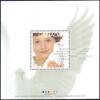
Another question that collectors often ask is: What is the difference between a full pane (sometimes just called a pane) and a souvenir sheet? Granted, it can be a little tricky sometimes to tell the two apart. For the purposes of understanding the differences, this article will compare a full pane to a souvenir sheet that Canada Post issued for the same stamp: Canada stamp #1813 (full pane ) and #1813i (souvenir sheet).

One thing to remember–these are not hard and fast rules (these guidelines apply mostly to Canadian stamps). Unfortunately, they are very flexible, which leads to all the confusion in telling the two apart. Some exceptions to these rules will be listed at the end of the article. For the purposes of this article, we will therefore stick to Canada stamps and rely mostly on the definitions set out in the Unitrade Specialized Catalogue of Canadian Stamps.
One thing to remember: souvenir sheets and full panes are usually printed on water-activated gummed paper ( self-adhesives stamps are rarely made into souvenir sheets and full panes, but they can occasionally be made into a booklet pane, since self-adhesives are printed on cardboard stock, ideal for a booklet pane). We will discuss booklets and booklet panes in another article.
Differences between a full pane and a souvenir sheet:
1) A full pane always contains 4 or more stamps (usually multiples of the same stamp repeated on the sheet). A souvenir sheet can contain only 1 stamp, but generally has 2 or more (especially if a series was issued) enclosed within a decorative design.
2) The multiple stamps on a full pane are usually all stamps of the same denomination,


generally the domestic rate. On a souvenir sheet, the stamp(s) is either the current denomination for the domestic rate, USA rate or international rate. When there is more than one stamp on a souvenir sheet, often times the denominations are different from one stamp to the other. An entire souvenir sheet can be used for postage on an envelope or package (if it fits of course), making for an attractive display, although most people just collect them. As for panes, who really wants to stick 4, 8 or 16 times the same stamp on a packet?
3) A souvenir sheet usually has more artistic value; additional designs,

pictures, text, or sometimes the actual sheet is cut into an unusual shape; for example, Canada stamp #1970 and #2202 (see images above left). Also, a souvenir sheet is generally smaller in size than a full pane.
However, Canada Post doesoccasionally get creative with the layout of the stamps on its full panes (see right). But the souvenir sheets are often more decorative and very pretty.
Exceptions to the rule:

As mentioned, there is always an exception to the rule and that is no different in philately. For example, Canada stamp #1960 (United Nations International Year of Mountains) is listed as a souvenir sheet even though it is self-adhesive stamps printed on heavier booklet paper. It is probably named a souvenir sheet due to the circular design of the sheet as well as all the additional information about the stamps printed on the sheet.

Canada stamp #2111 could easily be mistaken for a souvenir sheet. It is very decorative, it has labeling and designs all over it, so why is it listed as a full pane? Probably because the pane contains doubles of each of the 4 stamps in the series (souvenir sheets very rarely repeat the exact same stamp, and when they do, they usually only repeat it twice and one of the stamps is often not valid for postage).

Note : in the 1960s, Canada Post began producing « miniature panes » in cello-paqs. These panes usually contained 25 stamps that were definitives of Queen Elizabeth. Each pane was sold in a protective, clear, cellophane package. This format was eventually discontinued.
So, there are booklets, booklet panes, full panes (or panes), miniature panes, printer’s sheets, post office sheets, souvenir sheets……AGGHHH !!!!
Hopefully this will help you out a little, but as you can see, this is a subject open to a lot of interpretation. The best thing to do is follow the listings in your Unitrade Specialized Catalogue of Canadian Stamps.